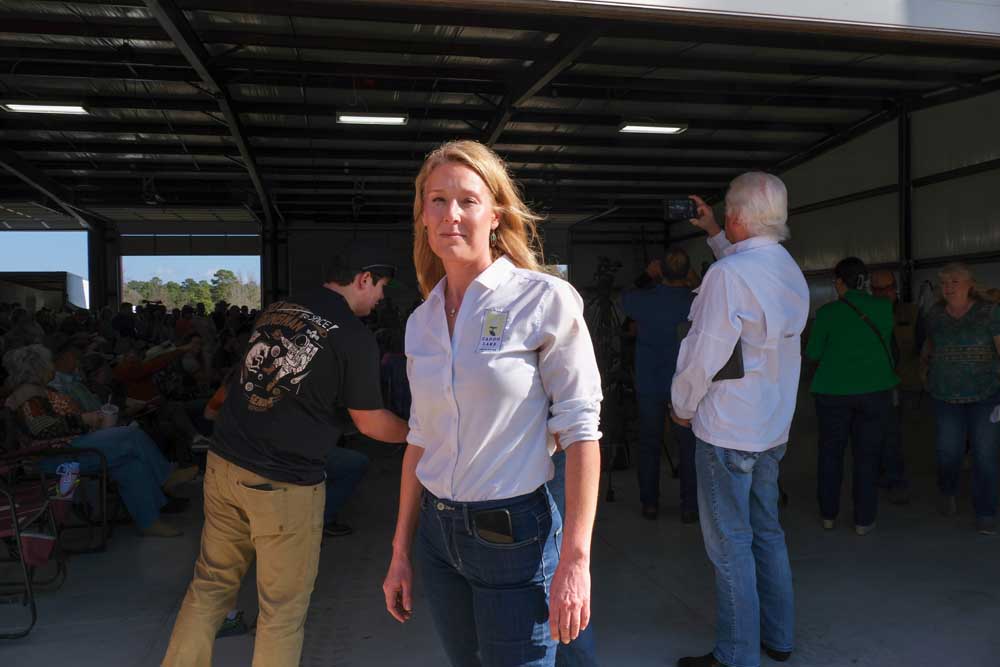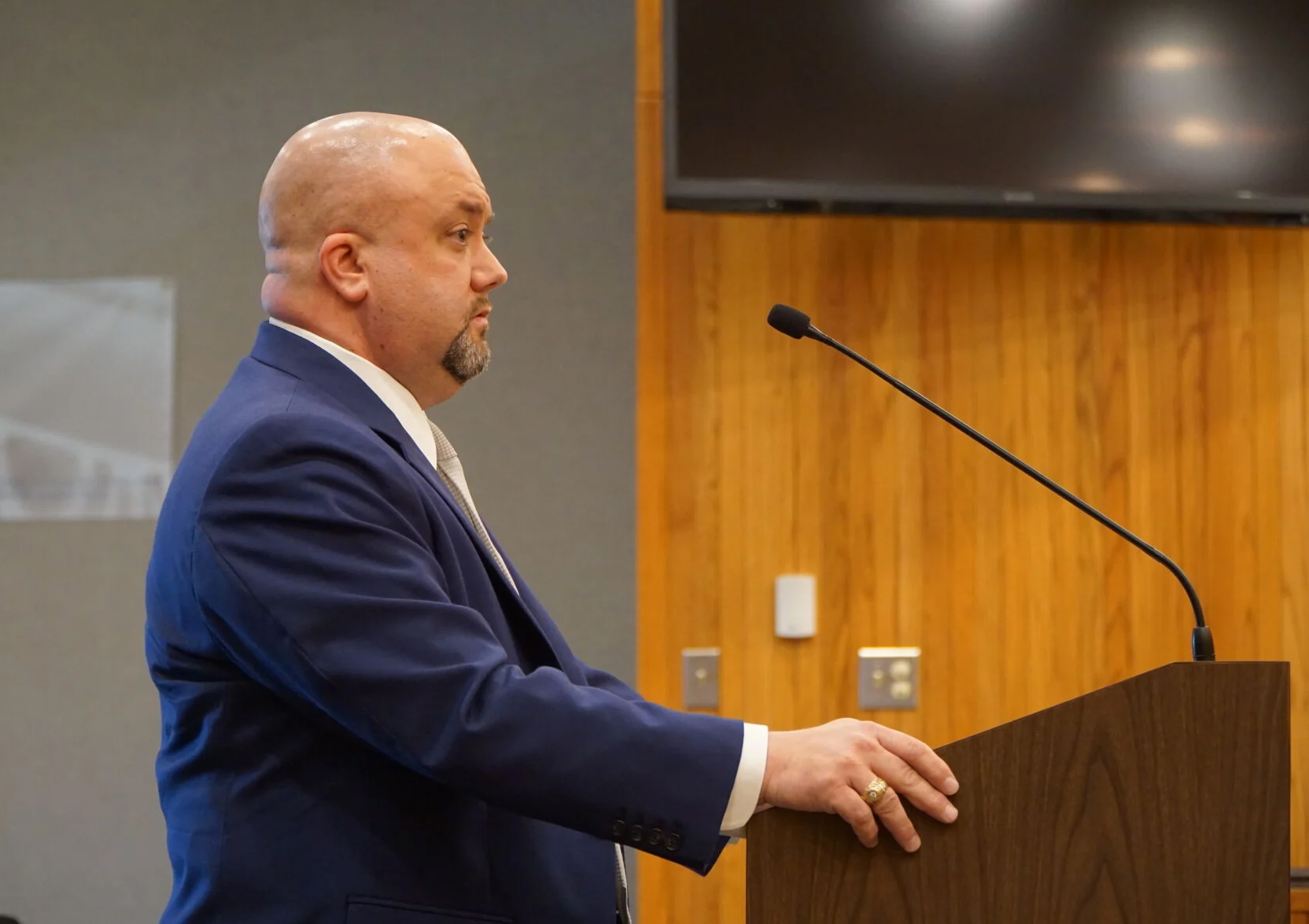Outrage over proposed Lake O’ the Pines water sale boils over, but murky details swamp debate
Published 3:45 pm Thursday, March 6, 2025

- Laura Ashley-Overdyke, the executive director for the Caddo Lake Institute, is seen during a Feb. 8 town hall at the Mims Volunteer Fire Department. The institute is a science-focused advocacy group for Texas' only naturally formed lake. Overdyke has been an outspoken opponent of the Lake O' the Pines water sale in its current form, though she said the institute would support a more limited water lease agreement with protections for Caddo Lake. (Samuel Shaw/Longview News-Journal Photo)
LAKE O’ THE PINES — The tightly-packed cars parked outside the Mims Volunteer Fire Department were a silent statement, cramming the shoulders along FM 729 for a quarter-mile.
The station’s fire engine bay had been emptied of emergency vehicles Feb. 8 for an impromptu town hall organized by state Rep. Jay Dean of Longview. Roughly 400 people and at least a dozen area officials had shown up at the fire station near Lake O’ the Pines that morning — and they weren’t there to fish.
Trending
They responded to a “call to arms” involving a “backroom secret deal” sale of water from Lake O’ the Pines to the Dallas area and the potential “decimation” of that lake as well as Caddo Lake if the sale is approved, as Dean posted on Facebook before the event.
“Caddo Lake would virtually become a mud hole,” he warned the crowd, explaining how voluntary water releases from Lake O’ the Pines sustain Caddo’s delicate wetland ecosystem downstream. Cities participating in the water sale could collapse their tourist economy and deprive themselves of property and sales taxes, he added.
Grassroots opposition spread through online groups in the following weeks at the same time as state representatives from Districts 1, 5 and 7 — encompassing the entire northeast corner of the state — arrayed against the potential water sale.
But the Northeast Texas Municipal Water District (NETMWD), the group pushing for the sale to the Dallas area and in charge of the majority of Lake O’ the Pines’ water, argues the image of dead lakes is a fiction spread by opponents of the deal.
A lack of concrete information on the proposal has swamped the surrounding debate in accusations of secrecy, misinformation and greed.
“The public is just imagining dried-up lakes, and that’s really not going to happen,” said NETMWD Executive Director Wayne Owen. “This is one of the most prolific watersheds in the state of Texas.”
Trending
While the finer points of the plan are still under wraps — or simply don’t exist yet, according to Owen — the information available by December was enough to alarm the Caddo Lake Institute, a scientific nonprofit organization dedicated to preserving Texas’ only naturally formed lake and widely considered to be a leading authority on the management of Caddo’s wetland habitat.
“This (deal) could be the straw that breaks Caddo’s back,” said Laura-Ashley Overdyke, the institute’s executive director.
Basics of the proposal
The North Texas Municipal Water District, the party in negotiations with NETMWD for Lake O’ the Pines’ water, is looking to secure future supplies in the fast-growing suburbs of McKinney, Plano, Frisco and Forney, among others, where rainfall is comparatively scarce and the groundwater depleted.
In total, NETMWD is exploring the permanent sale of water rights out of the Cypress River Basin amounting to roughly 88,000 acre feet annually, with an option to send an additional 44,000 acre feet in a wet season, according to Overdyke, who has discussed the plan with Owen several times during the past two years.
The total water on offer equates to 43 billion gallons — significantly more than is consumed annually in Salt Lake City, Utah, which has a population in excess of 200,000.
NETMWD is the largest water rights holder in the Cypress River Basin and is represented by seven board members appointed by seven city councils in Avinger, Daingerfield, Hughes Springs, Jefferson, Lone Star, Ore City and Pittsburg.
U.S. Steel, owner of the now defunct Lone Star Steel plant upstream from Lake O’ the Pines, is in possession of legacy water rights and also is involved with negotiations, Overdyke said.
The exact location of pipelines and where they would lead are unclear, but a recent board presentation by the North Texas Municipal Water District indicated an intake pipe could be on Lake O’ the Pines’ south shore and extend roughly 80 miles west to Lake Tawakoni.
Owen said NETMWD is subject to a non-disclosure agreement regarding negotiations until June, adding that he does not know those details regardless of the NDA.
The pipeline alone could cost as much $4 billion to construct, he estimated.
NETMWD has sought new customers for years, anticipating declines in sales to the region’s disappearing power plants that could spike water rates for residents.
The seven cities that appoint board members to NETMWD and control a portion of Lake O’ the Pines’ water would receive money from the sale, too, yet like other specifics of the plan, there is no concrete information on how much they stand to make.
George Ottstot, the NETMWD board member representing Jefferson, provided a clue during a presentation in December to the Jefferson City Council.
“The numbers involved are staggering; they’re life-altering,” he said. “Avinger (one of the seven cities in NETMWD) is very excited about what they’re going to get.”
Owen said the primary motivation behind the deal is the fiscal outlook for the water district. The cost of delivering water to customers is around $5 per 1,000 gallons, but NETMWD has subsidized that rate at $3.40/1,000 gallons using revenue from large electrical utility customers, including American Electric Power/SWEPCO and Vistra Corp., which have closed numerous fossil fuel power plants during the past decade.
Overdyke responded that the only major customers NETMWD lost were the Lone Star Steel plant and Vistra’s now demolished Monticello coal-fired plant.
Meanwhile, Dean said NETMWD had a current budget surplus exceeding $800,000, casting doubt on the supposed make-or-break reasoning driving a water sale.
Though negotiations are ongoing with Dallas-area buyers, Owen said NETMWD “has not received any type of proposal that is financially acceptable.”
Any finalized deal involving member cities would have to be ratified by member city councils with five of the seven agreeing to the sale.
Caddo’s lifeline
Despite the billions of gallons at play in the deal, it’s not the quantity of water that concerns the Caddo Lake Institute, it’s the access.
Caddo has no legal claim on the upstream water that sustains its fragile habitat of cypress trees, bottom land and sloughs. Its main upstream tributary, Big Cypress Creek, was plugged in 1953 to create Lake O’ the Pines and prevent disastrous floods to nearby Jefferson.
The negative downstream effects on Caddo Lake were poorly understood at the time, “so there were no protections put in place for ensuring Caddo’s water supply,” Overdyke said.
In 2014, following years of studies analyzing the importance of downstream flows for Caddo, an informal agreement was struck between NETMWD, the Army Corps of Engineers and a coalition of environmental groups to voluntarily release water from Lake O’ the Pines.
The agreement does not exist on paper and is only possible because the water supply at Lake O’ the Pines is mostly sufficient to meet the demands of the district’s customers as well as Caddo Lake, Overdyke said.
“But now here comes Dallas, and NETMWD says, ‘We’re still committed to these flows,’ but that’s a gentleman’s agreement in words only,” she added.
Overdyke — and a cadre of scientists the institute hired to study the possible water deal — fear that if Dallas-area suburbs are given legal priority to NETMWD’s water, it could drastically slash the frequency of water releases, potentially destroying Caddo.
“We would say approximately 70% of the time there is plenty of water over here and this sale would be no big deal,” Overdyke said. “However, 30% of the time it would be a big deal because there’s not enough water over here. So we have to figure out what to do about that 30% of the time.”
During the town hall in February, Overdyke said environmental releases were suspended for three years after a severe drought in 2011: “They didn’t have enough water then, and that was before the deal.”
Owen believes legal protections for Caddo’s water supply are unnecessary.
“It’s not a formal obligation, but it’s been voluntary, and it’s worked real well,” he said. “We’re committed and we’re gonna stay committed to Caddo Lake. This arrangement is going to continue… based on mutual trust.
“Could there be an excessive drought where we say, ‘We got to tap the brakes here (on the voluntary release)?’ Yes, because it’s going to be bad everywhere,” Owen said. “There’s shared suffering in extreme situations.”
Lake O’ the Pines accounted for less than 25% of Caddo’s annual inflows between 1993 and 2020, according to a NETMWD analysis of U.S. Geological Survey data.
Overdyke, however, countered that while the number is closer to 35% if all available survey years are included, there is another problem. The district lumped Caddo’s four other inflow streams into a single number to obscure how Lake O’ the Pines is the largest source of Caddo’s water.
For the Caddo Lake Institute, the possible consequences of the water deal are enough to warrant more robust guarantees regardless.
“Caddo is already an insanely shallow lake, about 4-to-6-feet deep, and the worst case scenario here is that it drops by a foot,” Overdyke said, citing a preliminary review of the plan developed by her team.
And Caddo is constantly getting shallower because of an invasive water plant called Giant Salvinia, which dies and sinks to the bottom, filling the lake from the bottom up.
The cascading effects from a reduction in Caddo’s water levels are myriad, she said. Giant Salvinia will be flushed out of the Mooringsport dam at the lake’s southern border less frequently, thus requiring further chemical treatments to control its spread, the use of which is already controversial among the lake’s residents.
Water temperatures would climb, and dissolved oxygen levels would drop, possibly resulting in large-scale fish die offs.
“At what temperature can the lake not sustain life?” Overdyke asks.
It’s a question on the minds of business owners who depend on the lake, too, including Keith Talley, who operates Uncertain Lodge and Inn at the lakeside community of Uncertain.
“I’ve got my life’s work invested here, and this is a natural resource that we’re going to kill if we allow this water to go away,” Talley said. “I’d lose everything.”
Overdyke said the institute would welcome a lease of water with tightly prescribed conditions on when it can leave East Texas, but not a permanent handover of water rights.
‘Brokered in the dark’
The way in which negotiations have taken place is at least as responsible for the ire around the proposed sale as its possible effects on two cherished East Texas lakes.
The fact that it was pursued for over a decade and spearheaded by a board of appointees, rather than elected officials, further aggravated area residents opposed to a deal.
Tensions came to a head in December when the proposition of a sale to the Dallas area was suddenly introduced to member city councils with little warning. That month in Jefferson, Ottstot, the NETMWD board member, told councilmembers that a finalized proposal would be available for a vote in executive session, meaning the public could not be present.
“They are doing this behind closed doors in secret,” Dean said during the town hall meeting. “That’s what’s disappointing to these people (in the crowd); it’s that their city councils appointed a member of the board and they’re over there negotiating with Dallas unbeknownst to anyone.”
Dean floated the idea of replacing the district’s board appointments with positions filled through city elections.
Former District 7 state Rep. David Simpson, who lives in Avinger, was similarly put off by what he saw as a lack of transparency at NETMWD.
“Despite the enormous consequences, this deal is being brokered in the dark. It would prioritize the Dallas area’s future over our own and put our region at risk during droughts,” he wrote in a February opinion column.
Seeking additional customers in the interest of member cities’ bottom lines is nothing new, Owen replied in a statement published after the February town hall meeting. “We have been selling water from Lake O’ the Pines for the past 60 years. These water sales have helped serve our neighbors and benefit our member cities financially.”
More to the point, Owen said, “There is no deal yet, and the board does everything in public meetings governed by the Texas Open Meetings Act.”
As for the decision to present details of the proposal to city councils in executive session, Owen said that was in accordance with the NDA the district signed that limited conversations about negotiated prices to stakeholders in the deal.
“I don’t think we’ll be signing more NDAs going forward,” Owen said as he ruminated about the anger this one produced.
‘Everybody thinks I’m a Trojan horse’
Owen’s professional and personal background has emerged as a catalyst for resentment and distrust some East Texans hold against denizens of the Dallas-Fort Worth area.
He was a longtime advocate of the controversial Marvin Nichols Reservoir project, a choice Owen described as a “stain I can’t wash off.” He also previously helped secure a $2.3 billion water pipeline from East Texas lakes to the city of Dallas and other North Texas water districts, which became operational in 2020.
“Everybody thinks I’m a Trojan horse,” Owen said.
Simpson took the analogy a step further.
“Wayne is like Odysseus,” he said in reference to the cunning protagonist in Homer’s “The Iliad,” who devised the Trojan horse, allowing soldiers to sack the ancient city of Troy.
Owen’s status as a part-time resident in the Fort Worth suburb of Benbrook made the accusations personal. His wife is a school teacher who was reluctant to move to East Texas on the eve of her retirement, Owen said, explaining the arrangement.
Dean seized the opportunity to cast the NETMWD director as the stereotypical Dallas-ite motivated by greed and vanity. To Dean, Owen personifies the conflict with Texas cities unwilling to conserve water but happy to siphon supplies out of rural communities. He struck a chord with the town hall crowd at Lake O’ the Pines.
“Wayne told me, ‘I don’t know why people are so upset with me on social media.’ I said, ‘Well, sir, you’re from Dallas,’ ” Dean recounted to hoots of approval. “The Dallas metropolitan area won’t stop until they own all of the Northeast Texas water basin. These people are relentless.”
Some in attendance at the Lake O’ the Pines gathering saw the proposed water sale as just the latest in a series of attempted water grabs by the Dallas area, citing the Marvin Nichols project and golf courses, pools and lawns as examples of a region refusing to get its own house in order.
“They don’t conserve water. They have no limits on what they do,” said Michelle Ready, a resident on the north shore of Lake O’ the Pines.
According to the Texas Water Development Board’s annual water consumption surveys, Region C’s largest water utilities — including many of the North Texas Water Districts customers — consume more water than comparable utilities do anywhere else in the state.
Plano, one of the municipalities listed in the proposed sale with NETMWD, recorded an average per-capita water consumption of 200 gallons a day in 2022, the most recent reporting year available.
The average rate for customers in Denver is 96 gallons per-capita per day (GPCD), while Las Vegas has dropped its average consumption to just below 90 GPCD.
Opposition spreads
Near Lake O’ the Pines and Caddo Lake, there are few local politicians or governing bodies left backing the water sale.
District 1 state Rep. Gary VanDeaver joined opponents as did District 5 Rep. Cole Hefner. Staffers representing U.S. Rep. Nathanial Moran’s office were in attendance at the Lake O’ the Pines town hall as well.
Weeks later, county commissioners in Morris, Marion, Upshur, Cass and Harrison counties all held symbolic votes against sales outside of Northeast Texas. The Jefferson City Council, where Ottstot had spoken to councilmembers only two months earlier, added to the chorus during a Feb. 18 discussion opposing the sale. The city of Lone Star also has voted against a deal.
The types of concerns voiced multiplied as word spread.
Residents with a stake in the lakes began to ask about the effects that such a sale could have on water tables, well water access, property values and tourist economies dependent on outdoor recreation.
NETMWD — and Owen in particular — have found themselves on the defensive.
“It’s been the worst month of my 41 year career,” he said in February. “This onslaught of public angst and concern is going to make it really difficult moving forward on anything.”
That’s good news for opponents of the sale, but Owen is steadfast in his belief that eventually, the district will need to find new customers somewhere — or residents will be making up the difference through water price hikes.






